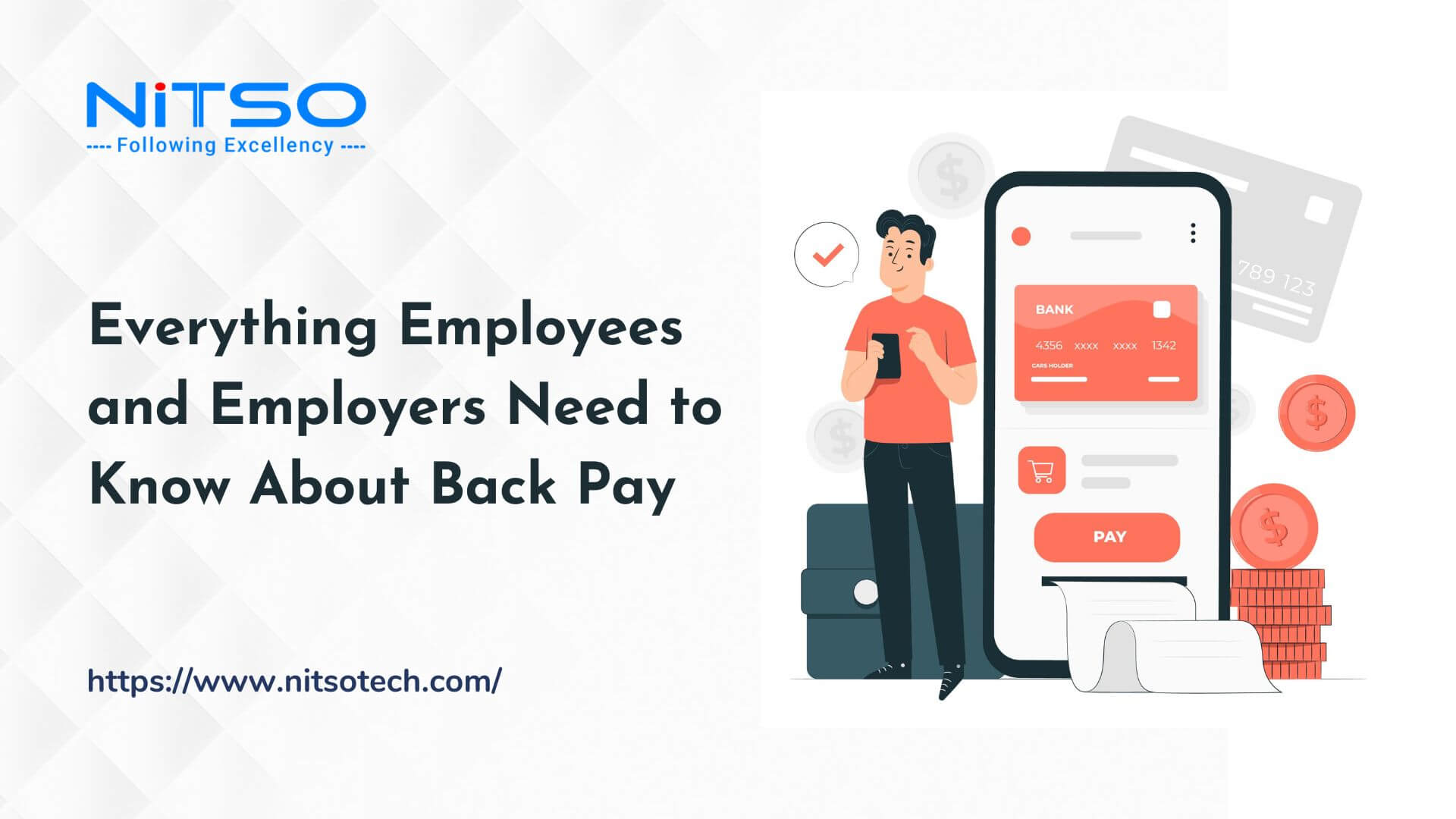Back pay is an important concept for both employers and employees to understand. It refers to compensation awarded for past work that was not properly paid by an employer. In this article, we will take a comprehensive look at back pay, including defining key terms, explaining how back payment is calculated and processed, eligibility criteria, and real-world examples. You’ll also learn about the difference between back pay and retro pay, online tools for estimating back payment, and the laws regarding back payments in India. Whether you are an employer trying to ensure proper compensation practices or an employee owed additional wages, understanding back pay is essential.
Table of Contents
What is Back Pay?
Back pay is compensation awarded to an employee for wages or benefits that should have been paid in the past but were not paid correctly or on time by an employer.
There are various situations when an employee may be determined to be owed back pay. Common examples include unpaid overtime, failure to provide required raises, retroactive compensation after a pay increase, or reinstatement of employment after a wrongful termination. Whatever the circumstances, back pay aims to reimburse employees and make up for lost compensation.
Some key things to know about back pay:
- It is the payment of wages owed from a prior period of time when they were not paid.
- The amount of back pay is typically calculated from the original date when wages should have been paid properly.
- It can include not just unpaid wages but also missed overtime, bonuses, commissions, and benefits.
- Back pay may be awarded in circumstances like wrongful termination, when an employee is reinstated, or after a pay increase is made retroactive.
- There are laws and regulations like the Fair Labor Standards Act(FLSA) that require back payment in cases of minimum wage violations.
- Employers are expected to pay any back wages owed to an employee in a timely manner once identified.
So in essence, back pay is a retroactive payment that compensates employees as required by law when they have not been paid fully or correctly for time worked in the past.
Retro Pay vs Back Pay
Retro pay and back pay are two types of retroactive compensation for employees, but they have some key differences:
Retro Pay:
- Refers to pay that is made retroactive after a new pay rate is implemented, such as after a raise.
- Retro pay makes up for the difference between the old pay rate and the new increased rate from the effective date of the raise.
- It is essentially extra pay to compensate for the higher rate not being made effective sooner.
Back Pay:
- Refers to compensation for wages that were not paid fully or on time in the past.
- Back pay aims to reimburse employees owed wages had they been paid correctly originally.
- It involves payment owed for past work periods, not just a retroactive rate change.
- Reasons include minimum wage violations, wrongful termination, unpaid overtime, etc.
- Back pay calculations are based on the wages already earned but not properly paid.
In summary, retro pay is catching up with a new pay rate, while back pay is compensating for previous pay differences. Both provide employees additional owed compensation, but back pay is recovering lost wages versus retro pay adjusting for a rate increase.
Factors in Making Back Payments
When an employer determines that an employee is owed back pay, there are a number of important factors to consider in calculating and making the back payment:
- Applicable laws and regulations – The Fair Labor Standards Act, state wage laws, and union contracts all dictate back pay requirements.
- Reason for the underpayment – Was it incorrect minimum wage, unpaid overtime, wrongful termination, etc?
- Time period when underpayment occurred – Back pay typically covers the entire period wages were owed.
- Earnings that should have been paid – Base wages, overtime, bonuses, and other compensation.
- Benefits owed – Any unpaid or missed benefits like health insurance, or retirement contributions.
- Interest – Some laws require interest to be paid on the back wages owed.
- Tax implications – Back pay may be subject to payroll taxes when paid out.
- Company policies – Internal processes may determine timing, approvals, and how paid.
- Documentation and calculation methods – Payroll records help calculate amounts due.
How is Back Pay Calculated?
When an employer determines an employee is owed back pay, calculating the amount due involves several steps:
- Identify the time period – The start and end dates when wages were not paid correctly. This establishes the duration of back pay.
- Determine required pay rates – The applicable hourly wage, salary, or piece rates during the period based on role and tenure.
- Calculate owed earnings – Determine the total pay that should have been earned for all regular and overtime hours worked during the period.
- Factor in bonuses and commissions – Any bonuses, commissions, or incentives earned during the period.
- Add value of missed benefits – Such as insurance premiums, retirement matches, or other benefits not received.
- Subtract mitigating earnings – Deduct any wages earned at other jobs during the period.
- Adjust for interest – Some laws require adding interest on the back wages owed.
- Account for taxes – Appropriate payroll tax withholding will need to be deducted.
- Consider company policies – Internal processes may impact how back payment is determined.
- Document calculations and methodology – Keep clear records of all figures used and steps followed.
The goal is to identify the actual amount the employee should have been paid versus what was paid to determine the total gross back pay owed. This requires detailed payroll records and wage data to calculate properly.
Example of Back Payment Calculation:
Let’s say Priya worked as a sales assistant at a company in Bangalore from January to June 2022.
- The back pay period is January to June 2022.
- Priya’s monthly salary was ₹15,000 per month as per her employment contract.
- However, Priya was only paid ₹12,000 per month during this period.
- So each month, Priya is owed ₹3,000 in unpaid wages.
- For the 6-month back pay period, Priya is owed 6 * ₹3,000 = ₹18,000 in unpaid salary.
- Priya was also not paid annual leave as per the company policy of 12 days of leave. This is valued at ₹3,000.
- Priya did not have any other employment during this period.
- The interest of 12% per annum will be added as per the Payment of Wages Act. This equals ₹1,080 in interest.
- TDS tax deduction will be made on the full back pay amount.
In total, Priya’s back pay calculation is ₹18,000 (unpaid salary) + ₹3,000 (leave pay) + ₹1,080 (interest) = ₹22,080 total gross back pay owed.
This example illustrates how to factor in unpaid wages, benefits, interest, taxes, and other elements per Indian regulations when determining back pay amounts.
How Back Pay is Processed?
Once back pay amounts are determined, there are procedural steps to make the payment:
- Obtain internal approvals – Companies may require sign-off by managers, legal, HR, payroll, and finance.
- Classify payment correctly – Ensure accounting codes as retroactive wage payments.
- Calculate and withhold taxes – Payroll tax deductions need to be applied.
- Issue payment – Traditionally as a paper check, but can be direct deposit.
- Provide documentation – Give employee documentation explaining payment details.
- Have employees acknowledge receipt – Have them sign a confirmation of receiving funds.
- Report and record payment – Update payroll systems and issue amended tax forms.
- Update policies – Review practices to avoid repeat issues in the future if systemic.
Reasons for Back Pay
There are various real-world examples of situations resulting in back pay to employees in India:
- Minimum wage violations – For instance, when domestic helpers are underpaid unlawfully by employers. Back pay claims help secure lawful minimum wages.
- Unpaid overtime – Failure to pay eligible overtime rates as mandated by overtime pay laws.
- Wrongful termination cases – When a wrongfully terminated employee gets reinstated by a tribunal’s order, the company has to provide back pay for lost earnings.
- Retroactive pay increases – Sometimes pay scale revisions are made retroactively. Back payment helps compensate for the prior lower pay rate.
- Commissions and bonuses – If contractual bonuses are delayed significantly, employees may claim back pay of owed amounts with interest.
- Improper payroll deductions – Reimbursement for deductions wrongly taken from pay.
- Unpaid leave and benefits – Failure to provide proper maternity leave pay or required paid time off can prompt back pay claims.
- Late final paycheck – Penalties for not paying final wages timely after termination.
Eligibility for Back Pay
Whether an employee is eligible to receive back pay depends on several factors:
- Employment status – Back pay generally only applies to current or former employees, not independent contractors.
- Protected categories – Discrimination back pay covers employees protected under equal employment laws.
- Union membership – Collective bargaining agreements outline back-pay rights for union members.
- Exempt vs. non-exempt – Overtime back pay typically only applies to non-exempt employees.
- Nature of compensation – Commissions, bonuses, and benefits may be treated differently than base wages.
- Laws and policies – Eligibility will depend on applicable federal, state, and local laws as well as company policies.
- Reason for claim – Valid claims like minimum wage violations differ from invalid claims.
- Documentation – Adequate records to substantiate the back pay eligibility and amounts owed.
Online Back Pay Calculators
Various online tools and calculators can help estimate potential back pay amounts owed. Some examples include:
- Back Pay Calculator – Offered by the U.S. Department of Labor to calculate back wages for federal minimum wage violations.
- Outten & Golden Calculator – Allows inputs for regular and overtime back pay along with interest.
- FindLaw Back Pay Calculator – Estimates back pay for unpaid overtime situations.
- Nolo Back Pay Calculator – Calculates back overtime pay based on federal labour laws.
- Back Pay Calculator by EmploymentLawFAQ – Simpler tool to estimate basic back overtime pay amounts.
These calculators ask for inputs like pay rate, hours worked, overtime details, and other factors to generate back pay estimates. They incorporate formulas based on federal and state labour laws.
How payroll management software can help with back pay?
- Automation of calculations – Payroll Software can be configured to automatically calculate back pay amounts based on set rules and formulas. This ensures accuracy and consistency.
- Access to historical data – Payroll systems contain years of pay rates, hours, benefits and other historical data needed to compute back pay.
- Audit trails – Activity logs provide transparency into back pay calculations for compliance.
- Integration with HR system – Important context from HR on employee status changes, leaves, terminations etc can inform back pay decisions.
- Reporting – Custom reports can be generated showing back pay details for each employee. Helps with processing.
- Tax handling – Payroll software can automatically deduct proper taxes on back payment and handle filings.
- Compliance features – Tools like state law tracking help align with labour regulations pertaining to back wages.
- Workflow enablement – Built-in approval chains can be established for back pay decisions and payouts.
By centralizing data, automating calculations, ensuring compliance, and streamlining back pay processing, payroll management systems are invaluable tools for organizations managing retroactive pay scenarios.
Conclusion
Back pay is an important but often complex component within compensation law and employment practices. Failure to fully understand back payment requirements and calculations can lead to wage disputes, financial liabilities, and regulatory non-compliance for employers.
Employees who are owed additional wages from past work periods also need to be aware of their rights and eligibility criteria to obtain fair compensation. A careful review of applicable laws, contracts, and policies is imperative.
By taking a proactive approach, employers can minimize risks and demonstrate commitment to fair pay. Employees should also consult with legal counsel to validate claims and resolve back pay matters advantageously when warranted.
FAQs Related to Back Payments
How to track my disability back pay?
You can track your disability back pay status by creating an online account on the Social Security Administration’s website. This allows you to view your payment history, including if any back pay amounts have been released or processed. You can also contact your local Social Security office to request an update.
Is retroactive pay the same as back pay?
No, retroactive pay and back pay are different. Retroactive pay is additional compensation received when a new pay rate is made effective retroactively, usually after a pay raise. Back pay is compensation for wages you should have received in the past but did not get fully paid by your employer.
How to ask for back pay?
To ask for back pay, first document how much you believe you are owed and the reasons why, with evidence like time records. Raise the issue in writing with your manager and HR department, specifying the back pay amount owed based on unpaid wages. You can also file a formal wage claim with your state labour department.
How long does an employer have to pay you back pay?
Federal law does not specify a timeframe for employers to pay owed back wages. But state wage payment laws often require employers to pay back wages promptly, such as within the next pay period or within 30 days. Interest may accrue on unpaid back pay in some states.
How do you calculate back pay?
Common steps to calculate back pay amounts include: documenting the time period owed, determining appropriate pay rates, calculating total owed earnings, factoring in benefits and bonuses, subtracting mitigating earnings, and adjusting for taxes and interest. Supporting records like timesheets help determine exact amounts.
Is back pay taxed?
Yes, back pay is considered taxable income by the IRS and employment taxes like FICA and Medicare must be withheld from the gross back pay amount. Your employer should handle these withholdings when processing the back pay.
What is the meaning of back-due payment?
Back-due payment refers to payment for goods or services that you received in the past but did not pay for at the time. It can also refer to wages earned in previous pay periods that were not paid fully or on time by an employer, which is essentially back pay.
What is a retro pay example?
An example of retroactive pay is when a new union contract is negotiated to grant a pay raise retroactive to 6 months ago. Employees then receive retro pay to compensate for the period when the raise was not yet in effect.
What is it called to pay back?
To pay back usually refers to repaying a debt or loan amount owed. It can also mean providing back pay or retroactive compensation to an employee for prior unpaid or underpaid wages.
Is it payback or pay back?
Payback as one word refers to retaliation or revenge. In two words, “pay back,” refers to repaying money owed, such as wages through back pay.
When can I get my back pay?
The timing of receiving back pay depends on factors like your employer’s next pay cycle, how promptly they process payments after determining amounts owed, and any state laws dictating specific payment deadlines. Communicate with your employer to understand when your back pay will be issued.
Is back pay mandatory?
There is no universal law requiring back pay in all cases. But specific laws, union contracts, and state wage statutes establish mandatory back pay in certain situations, such as Fair Labor Standards Act violations for minimum wage.
How long can a company hold salary after resignation?
Most states require employers to pay outstanding wages, including earned salary, to resigned employees at the next regular payday. Withholding pay beyond the next pay period after voluntary resignation is generally unlawful, barring a formal forfeiture policy communicated in advance.








0 Comments